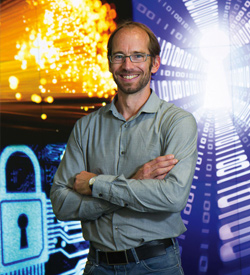 Collaboration between quantum scientists and the City of Calgary sets a distance record for teleporting a photon over a fibre network.
Collaboration between quantum scientists and the City of Calgary sets a distance record for teleporting a photon over a fibre network.
What if you could behave like the crew on the Starship Enterprise and teleport yourself home or anywhere else in the world? As a human, you’re probably not going to realize this any time soon; if you’re a photon, you might want to keep reading.
Through a collaboration between UCalgary, the City of Calgary and researchers in the United States, a group of physicists led by Wolfgang Tittel, professor in the Department of Physics and Astronomy, have successfully demonstrated teleportation of a photon (an elementary particle of light) over a straight-line distance of six kilometres using the city’s fibre optic cable infrastructure. The project began with an Urban Alliance seed grant in 2014.
This accomplishment, which set a new record for distance of transferring a quantum state by teleportation, has landed the researchers a spot in the prestigious Nature Photonics scientific journal.
City’s accessible dark fibre makes research possible
The research could not be possible without access to the proper technology. One of the critical pieces of infrastructure that support quantum networking is accessible dark fibre. Dark fibre, so named because of its composition — a single optical cable with no electronics or network equipment on the alignment — doesn’t interfere with quantum technology.
The City of Calgary is building and provisioning dark fibre to enable next-generation municipal services today and for the future.
“By opening the city’s dark fibre infrastructure to the private and public sector, non-profit companies and academia, we help enable the development of projects like quantum encryption and create opportunities for further research, innovation and economic growth in Calgary,” says Tyler Andruschak, project manager with Innovation and Collaboration at the City of Calgary.
“The university receives secure access to a small portion of our fibre optic infrastructure and the city may benefit in the future by leveraging the secure encryption keys generated out of the lab’s research to protect our critical infrastructure,” says Andruschak. In order to deliver next-generation services to Calgarians, the city has been increasing its fibre optic footprint, connecting all City buildings, facilities and assets.
Timed to within one millionth of one millionth of a second
As if teleporting a photon wasn’t challenging enough, Tittel and his team encountered a number of other roadblocks along the way.
Due to changes in the outdoor temperature, the transmission time of photons from their creation point to City Hall varied over the course of a day.
“The challenge was to keep the photons’ arrival time synchronized to within 10 pico-seconds,” says Tittel. “That is one trillionth, or one millionth of one millionth of a second.”
Secondly, parts of their lab had to be moved to two locations in the city, which, as Tittel explains, was particularly tricky for the measurement station at City Hall that included state-of-the-art superconducting single-photon detectors developed by the National Institute for Standards and Technology and NASA’s Jet Propulsion Laboratory.
“Since these detectors only work at temperatures less than one degree above absolute zero, the equipment also included a compact cryostat,” says Tittel.
This demonstration is arguably one of the most striking manifestations of a puzzling prediction of quantum mechanics, but it also opens the path to building a future quantum Internet, the long-term goal of the Tittel group.
The Urban Alliance is a strategic research partnership between the City of Calgary and UCalgary, created to encourage and co-ordinate the seamless transfer of cutting-edge research between the university and the city for the benefit of all our communities. U
← Back to In the Field









